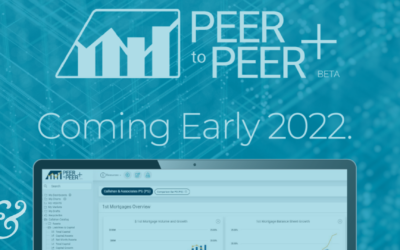Strategic planning gives credit union management teams the opportunity to come together and formulate a plan to guide their institution. Such engagements have mostly moved into the virtual realm; however, the importance of this melding of minds cannot be understated. Incorporating peer analysis is an ideal way to kick-start a strategic conversation and enhance the impact of planning. After all, equipped with current, verified financial data, leaders can more easily spot weaknesses to correct as well as identify areas on which to capitalize.
Here are a few key ratios and high-level areas to start your discussion.
Growth Trends
Membership Growth: A credit union’s business strategy is a major driver of its member growth. More effective strategies for a given marketplace typically yield stronger member growth. The board’s philosophy toward service levels, delivery channels, product pricing, and breadth of services also influence member growth.
Additionally, member growth is a great litmus test for evaluating the introduction of new products and services by a credit union.
Asset Quality
Delinquency Ratio: The delinquency ratio measures the credit risk of a loan portfolio. It is a forecaster of future loan losses; therefore, unusual increases or decreases generally affect future earnings. The level of delinquency a credit union can sustain is a function of several factors, including loan income, credit risk management, and loan loss management. Risk-based pricing is often accompanied by higher delinquency, but credit unions typically compensate for that higher delinquency by charging higher interest rates and in turn, achieving higher loan yields.
Ratios relative to asset quality are top-of-mind for credit union leaders as we measure the short and long-term impacts of COVID-19.
Business Model
Loan-To-Share Ratio: A credit union’s loan and deposit acquisition performance drives its loan-to-share ratio. Unless liquidity is an issue, most credit unions concentrate on building the loan portfolio rather than focus on deposits.
A credit union’s operations — sales culture, marketing, product development, risk management, etc. — generally influences loan growth more than deposit growth. Non-operational factors, such as membership demographics, are what tend to influence deposit growth.
A higher loan-to-share ratio typically indicates greater profitability, and in broader terms, is an indication of how efficiently a credit union is leveraging its deposit portfolio to achieve stronger performance and create member value.
Productivity And Member Relationships
Members Per Employee (FTE): The members per employee ratio measures the productivity of a credit union’s employee base. In theory, a higher ratio means a credit union is more productive, but other factors also play a part.
When examining the ratio, credit unions should also consider product penetration rates, members per branch location, the geographic distribution of the membership, and field of membership requirements. Strategic factors that impact the ratio include organizational goals — sales versus service models — growth, and product and technology development.
How To Get Started With Data
Callahan & Associates’ Peer-to-Peer software contains hundreds of pre-built financial graphs and tables to assist in strategic planning. Knowing where to start and choosing what to analyze can be daunting, but that shouldn’t stop teams from putting together a relevant financial analysis presentation.
Request a custom Strategic Planning Trend Report.
We’ll show you the ins and outs of Peer-to-Peer while creating a custom scorecard for your credit union to use during your next planning session of board meeting.
This blog has been condensed and originally appeared on our content website, CreditUnions.com.
Click here to read the full article.
More Blogs
Top 5 Webinars Of 2021 On CreditUnions.com
Through all the ups and downs, twists and turns that 2021 put the credit union industry through, Callahan has continued empowering credit unions to impact their communities in meaningful ways. That includes our webinars, which offer key insights into a variety of...
Top 5 Articles Of 2021 On CreditUnions.com
It has been a lively year for the credit union industry. A year that started in the throes of COVID-19 has now given way to nationwide economic reopening tempered by labor shortages, inflation, and now, concerns about yet a new variant. Through it all,...
3 Themes For Credit Union CEOs Leading Into 2022
Credit unions have reported a string of significant milestones across 2021. Over the past few months, we've been able to speak with hundreds of credit leaders and wanted to share some of the key themes we’ve been hearing. Digital Transformation Digital transformation...
Alternative Data Sets And How They Can Help Your Credit Union
For credit unions, there’s no such thing as “too much data”. If there’s data that exists for credit unions to get a better gauge on their role in the local community or in the industry at large, it’s in the cooperative’s best interest to uncover it. While typical...
A Successful Launch Starts With A Successful Team
People often ask me why I’m such a passionate credit union advocate. OK, to be honest, the question is usually more along the lines of “why are you obsessed with credit unions”, and the “people” in question are my friends, family, neighbors, kids’ friends’ parents,...
Webinar Recap: How Callahan Quantifies Credit Union Impact
We recently hosted “Measure Your Mission: How To Quantify Credit Union Impact” as part of the quarterly Tableau User Group (TUG) engagement webinar. In it, we outlined the goals of Callahan’s impact initiative, how impact metrics are quantified, and what credit unions...
3 Ways To Use 2Q21 Data
The NCUA has officially released second quarter credit union data. Callahan provides your credit union a multitude of ways to analyze this updated data to benefit your cooperative. Here are three: 1. Build custom tables in Peer-to-Peer In Peer-to-Peer, credit unions...
Recapping The Impact Network Meet-Up
On August 17, dozens of credit unions joined Callahan & Associates for the first ever Impact Network Meet-Up. This event, which was open to Impact Network participants only, was created to help participating credit unions form connections, start impact-related...
2Q21 Credit Union Trends and Takeaways
More than 1,200 industry peers joined us on Aug. 11 for 2Q 2021 Trendwatch. Callahan highlighted trends in lending, membership, and more as behavior amongst credit union members changed in accordance with the steady economic reopening. Most notably, credit union...
We’re Re-Building Peer-To-Peer From The Ground Up, Here’s What You Can Expect
Intuitive design. Faster analysis. Enhanced reporting. All packaged into a sleek, modern interface. Those are just a few of the changes you can expect with the launch of Callahan’s Peer+ software, coming January 2022. We’re excited to share that the classic...











